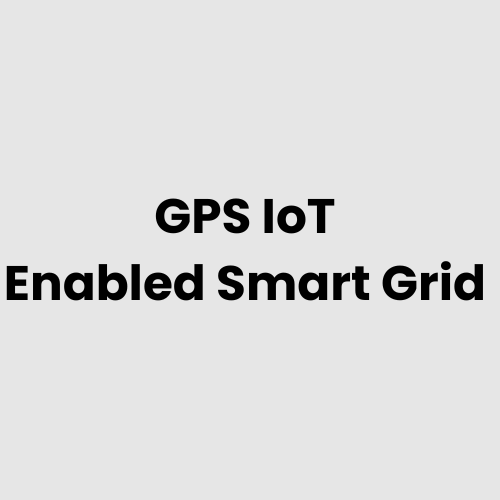GPS IoT Enabled Smart Grid
Explore the technical architecture, hardware details, deployment considerations, and cloud integration of our GPS IoT Enabled Smart Grid.
Description
Technical Architecture of the GPS IoT Enabled Smart Grid
The GPS IoT Enabled Smart Grid employs a modular and scalable architecture that integrates advanced IoT technologies with GPS-enabled synchronization for efficient power management. The system features real-time monitoring, predictive analytics, and seamless communication across grid components. It comprises three layers:
- Perception Layer: Comprising IoT-enabled sensors and GPS modules, this layer collects data such as voltage, current, temperature, and geolocation.
- Network Layer: Utilizes advanced communication protocols like Zigbee, LTE, and Wi-Fi to transmit data securely and efficiently.
- Application Layer: Includes AI-driven software for predictive maintenance, load optimization, and user-friendly dashboards for actionable insights.
GAO Tek offers expert guidance in configuring these systems for diverse energy distribution networks.
Hardware of the GPS IoT Enabled Smart Grid
- IoT-enabled smart meters
- GPS modules for real-time synchronization
- Sensor arrays (current, voltage, and temperature sensors)
- Edge computing devices and gateways
- Network communication modules (Zigbee, LTE, Wi-Fi, and Ethernet)
- Power transformers with integrated sensors
- Backup power systems (UPS or batteries)
- Data storage servers and processors
- SCADA (Supervisory Control and Data Acquisition) systems
- Environmental monitoring devices
GAO Tek supplies and supports all the essential hardware components to ensure robust system functionality.
Physical Placement Considerations for Hardware
- Smart Meters: Installed at consumer premises for real-time data capture.
- GPS Modules: Strategically placed on substations and transformers for precise time and location data.
- Sensors: Distributed across the grid, including power lines and substations, to monitor performance.
- Edge Devices: Positioned near data sources for low-latency processing.
- Communication Modules: Installed in locations ensuring strong signal coverage.
- Environmental Monitoring Devices: Deployed in weather-sensitive areas.
GAO Tek ensures optimal hardware placement to maximize operational efficiency and data accuracy.
Hardware Architecture of the GPS IoT Enabled Smart Grid
The hardware architecture integrates sensor networks, GPS modules, and communication interfaces with centralized and edge computing capabilities. Key features include:
- Sensor-Device Layer: Collects environmental and operational data.
- Communication Layer: Securely transmits data using IoT communication protocols.
- Processing Layer: Performs real-time analytics using edge and central servers.
- Control Layer: Provides actionable insights for grid management.
GAO Tek designs and delivers this robust architecture to meet diverse customer needs.
Deployment Considerations
- Scalability: Ensure future expandability for increasing grid demands.
- Redundancy: Incorporate backup systems for uninterrupted operation.
- Cybersecurity: Deploy end-to-end encryption and firewalls.
- Compliance: Adhere to regional and international standards.
- Integration: Ensure compatibility with existing grid components.
GAO Tek leverages its expertise to provide tailored deployment strategies for clients.
List of Relevant Industry Standards and Regulations
- IEEE 2030 (Smart Grid Interoperability Standards)
- IEC 61850 (Substation Automation Standards)
- ISO/IEC 27001 (Information Security Management)
- NERC CIP (Critical Infrastructure Protection Standards)
- ANSI C12 (Electric Metering Standards)
- FCC Part 15 (Wireless Communication Compliance)
- GDPR/CCPA (Data Privacy Regulations)
Local Server Version
The GPS IoT Enabled Smart Grid can operate using a local server setup, ideal for environments requiring high-security data handling or limited internet access. This configuration includes on-premises servers for data storage and analysis, ensuring compliance with stringent data privacy norms. GAO Tek provides comprehensive installation and maintenance services for local deployments.
Cloud Integration and Data Management
Our cloud-enabled version integrates seamlessly with major platforms, offering centralized data storage, real-time processing, and global access to system analytics. Features include:
- Scalable Storage: Accommodates growing data needs.
- AI-Powered Analytics: Enables predictive maintenance and demand forecasting.
- Secure Access: Supports multi-factor authentication and encrypted communication.
GAO Tek’s cloud solutions deliver unmatched reliability and flexibility for managing modern smart grid systems.
GAO Case Studies of GPS IoT Enabled Smart Grid
Case Studies in the USA
- Smart Grid Optimization in Chicago, Illinois
In Chicago, our GPS IoT Enabled Smart Grid system was deployed to enhance power distribution efficiency in urban areas. The project included real-time monitoring of energy consumption and GPS-synchronized load balancing, resulting in a 20% reduction in outages. GAO Tek provided cutting-edge hardware and expert guidance for seamless implementation. - Disaster-Resilient Grid in Houston, Texas
Following major storms, Houston adopted a GPS IoT Enabled Smart Grid to improve resilience. GAO Tek supported the integration of GPS-enabled sensors and predictive analytics, enabling real-time fault detection and rapid recovery from disruptions. - Renewable Energy Integration in Denver, Colorado
Denver implemented our smart grid solutions to facilitate solar and wind energy integration. GAO Tek’s system enabled efficient synchronization of renewable sources with traditional grids, optimizing energy storage and distribution. - Rural Grid Expansion in Lincoln, Nebraska
Lincoln addressed energy distribution challenges in rural areas by leveraging GPS IoT technology. GAO Tek enabled the deployment of IoT-enabled sensors to monitor grid performance and maintain consistent energy delivery. - Smart City Initiative in New York City, New York
As part of New York City’s smart city programs, GAO Tek helped implement a GPS IoT Enabled Smart Grid, integrating real-time analytics and IoT-driven demand management. The system improved energy efficiency in densely populated areas. - Microgrid Deployment in Los Angeles, California
GAO Tek supported the design and deployment of microgrids in Los Angeles, incorporating GPS-enabled IoT solutions for localized energy management. This approach minimized dependence on centralized grids during peak loads. - Campus Energy Efficiency in Boston, Massachusetts
A major university in Boston collaborated with GAO Tek to implement an IoT-enabled smart grid on its campus. The system provided detailed energy consumption insights and optimized energy use across multiple buildings. - Industrial Grid Modernization in Detroit, Michigan
Detroit’s industrial zones benefited from GAO Tek’s GPS IoT Enabled Smart Grid, which improved energy allocation and reduced downtime by integrating real-time performance monitoring systems. - Grid Fault Detection in Phoenix, Arizona
Phoenix deployed GAO Tek’s smart grid solutions to detect and resolve grid faults. The system’s GPS-synchronized fault detection reduced response times by 30%, enhancing grid reliability in high-demand periods. - Smart Meter Rollout in Atlanta, Georgia
Atlanta implemented a comprehensive smart meter program powered by GAO Tek’s IoT solutions. The system provided real-time usage data to consumers, promoting energy conservation and transparent billing. - Load Management in Miami, Florida
GAO Tek’s smart grid technology enabled Miami to balance energy loads during peak demand, preventing outages. The system’s advanced analytics improved load forecasting and distribution efficiency. - Smart Grid Pilot in Seattle, Washington
Seattle piloted GAO Tek’s GPS IoT Enabled Smart Grid to test advanced demand-response capabilities. The system delivered measurable improvements in energy efficiency and user satisfaction. - Enhanced Grid Monitoring in Nashville, Tennessee
Nashville implemented GAO Tek’s grid monitoring system, which used GPS-enabled sensors to provide real-time data on energy flow and system health. This reduced maintenance costs and outage duration. - Substation Modernization in Kansas City, Missouri
Kansas City utilized GAO Tek’s solutions to upgrade its substations with IoT-enabled monitoring and GPS-synchronized data management, ensuring seamless energy distribution. - Grid Security Enhancement in Dallas, Texas
GAO Tek partnered with Dallas to enhance grid security using GPS-enabled IoT sensors and encrypted communication protocols, safeguarding critical infrastructure against cyber threats.
Case Studies in Canada
- Grid Efficiency Improvement in Toronto, Ontario
GAO Tek assisted Toronto in optimizing its energy grid with IoT and GPS technology. The project improved grid reliability and reduced energy losses, supporting the city’s sustainability goals. - Remote Monitoring in Calgary, Alberta
Calgary deployed GAO Tek’s GPS IoT Enabled Smart Grid for remote grid monitoring in rural areas. The system’s advanced sensors and predictive analytics enabled efficient maintenance and ensured uninterrupted power supply.
Navigation Menu for GPS IoT
- GPS IoT Trackers/Devices
- GPS IoT Tracking Accessories
- GPS IoT Tracking Resources
- GPS IoT – Cloud, Server, PC & Mobile Systems
Navigation Menu for IoT
- LORAWAN
- ZIGBEE
- Wi-Fi HaLow
- Z-WAVE
- BLE & RFID
- NB-IOT
- CELLULAR IOT
- GPS IOT
- IOT SENSORS
- EDGE COMPUTING
- IOT SYSTEMS
Our products are in stock and can be shipped anywhere in the continental U.S. or Canada from our local warehouse. For any further information, please fill out this form or email us.
We are actively looking for partners who are like us located in the U.S. and Canada. For more information on partnering with GAO, please visit Partner with GAO Tek Inc. It lists various ways to partner with GAO, such as OEM Partnerships, Technology Integration, Distribution and Reselling Opportunities, Presenting at the Leading Event Tek Summit, Joint R&D Projects, Training and Consulting Services, Industry-Specific Collaborations, Research and Academic Partnerships.



